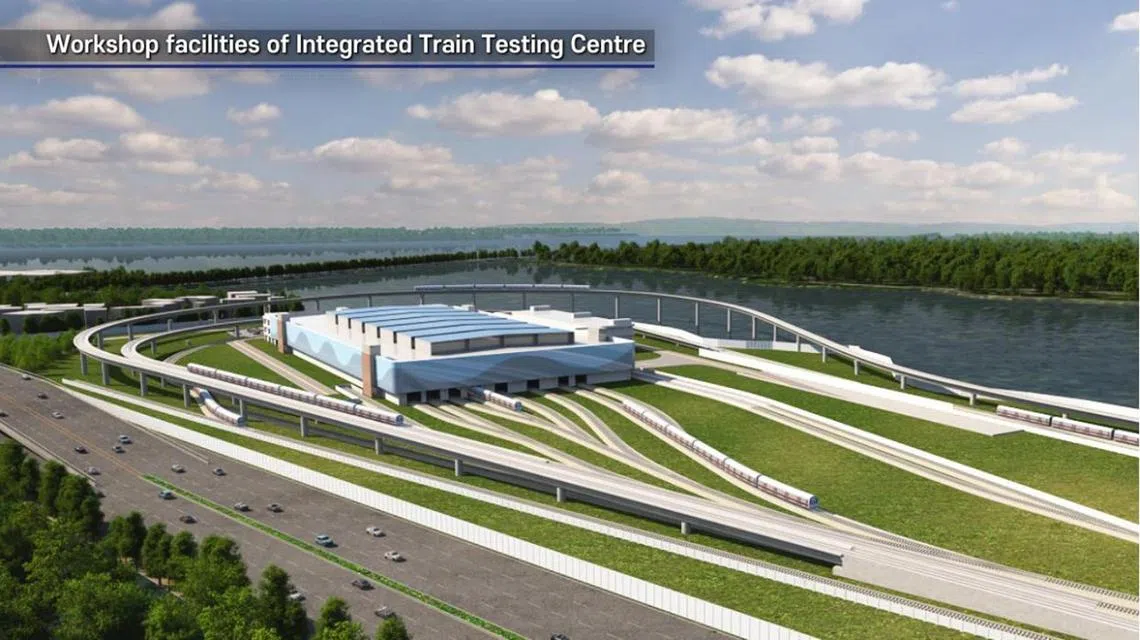High-speed tests on MRT trains now possible away from main rail lines at $640m facility
Sign up now: Get ST's newsletters delivered to your inbox
Follow topic:
SINGAPORE – Singapore can now test MRT trains at speeds of up to 100kmh away from its main rail lines, with the completion of the first phase of a new facility in Tuas.
The transport authorities unveiled a 3km high-speed MRT testing track at the Singapore Rail Test Centre (SRTC) on Thursday after more than two years of construction.
With engineering work on MRT lines here limited to 1am to 4am, when train services stop running, the new centre will free up more of this time for maintenance when it is fully completed in 2025.
This will help boost rail reliability, said Acting Transport Minister Chee Hong Tat at an event to mark the completion of the SRTC’s first phase.
At present, passengers have to bear with the inconvenience of early closures and late openings of MRT stations if there are not enough engineering hours to test new trains and systems, and do the necessary maintenance.
“Time used for testing is time that we could have used to maintain and service our tracks and other rail systems,” Mr Chee said.
“An ageing network requires more maintenance, and that is where SRTC comes in,” he added.
The new centre – the first of its kind in South-east Asia – will allow round-the-clock testing, as it is far from residential areas.
It sits on a 50ha site that once housed Raffles Country Club.
The land, near Tuas Checkpoint, was acquired in 2018 for the now-terminated high-speed rail project between Singapore and Kuala Lumpur.
Already, two new trains that will ply the upcoming Stage 6 of the Circle Line (CCL) are being put through their paces on SRTC’s new high-speed testing track ahead of their deployment in 2026, the Land Transport Authority said.
Stage 6 of the CCL will close the loop for the line, connecting the HarbourFront and Marina Bay stations.
Civil construction work on the SRTC, formerly known as the Integrated Train Testing Centre, is now about 85 per cent done.
Originally set for completion in 2024, the $640 million project was delayed by a year because of the pandemic.
The second phase of construction involves building two other test tracks, as well as an operations control centre, an administration building, and maintenance and refurbishment workshops.
These other test tracks are a 3km looped endurance track with a section that has an uphill gradient, and a 2.8km performance and integration track.
The endurance track will be used to test a train’s performance. It will also allow the train to clock enough mileage before deployment.
The performance and integration track will ensure that a train is well integrated with rail systems such as signalling and communications.
Mr Chee said on Thursday that when fully operational, the SRTC will allow Singapore to carry out rail testing under conditions mirroring those of its MRT lines.
This comes as Singapore enters a time of “unprecedented network expansion till the early 2030s”, with works on the Thomson-East Coast, Jurong Region and Cross Island MRT lines, and the expansion and renewal of existing lines, he added.
The integration of new systems and testing are also becoming more complex, and it would not be feasible for Singapore to rely on overseas testing centres, he said.
Without a train testing facility here, Mr Chee added, Singapore has had to use such overseas centres to test new rail assets such as trains and signalling systems.
For instance, the second fleet of trains for the North-South and East-West lines was tested in Prague, capital of the Czech Republic, in the early 1990s.
But these overseas centres cannot fully replicate local conditions, and thus, more tests are still needed when the equipment arrives in Singapore, Mr Chee said.
Similarly, existing systems that are being upgraded must be tested locally too.

An earlier artist’s impression of the Singapore Rail Test Centre, which was previously known as the Integrated Train Testing Centre.
PHOTO: LTA
Mr Chee said the SRTC will serve all MRT lines here.
This is unlike most overseas testing facilities, which private train manufacturers operate for their own equipment.
The hope is that the SRTC will help enhance the capabilities of Singapore rail workers, and test new technologies and systems, he added.
The facility also has the potential to become a regional testing centre serving expanding rail systems in neighbouring countries, he said.
Announced in 2019, the centre was moulded after similar testing centres in countries such as Germany, South Korea and Japan.
South Korean company GS Engineering clinched a $639.5 million contract in 2020 to design and build the centre, with civil construction work starting in 2021.


